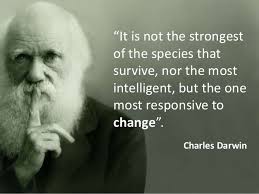First the controversy. Adapt or die. "It's not the strongest of the species that survives, nor the most intelligent that survives. It is the one that is most adaptable to change".
All have heard it. Many have used it. Few have believed it. None or very few have baked it into their DNA as a guiding principle. Are you up to the challenge?
Backstory
It turns out that Charles Darwin did not actually coin this quote. It was actually said by some guy talking about Charles Darwin in 1963 in a speech delivered by a Louisiana State University business professor named Leon Megginson. But it doesn’t really matter.
The whole world has been forced to come to terms with the “new normal” as a result of the COVID pandemic. And yet, despite being faced with the largest global health and economic catastrophe since World War II, most people are wired in such a way that we resist change until we get swept up by it.
Manna From Heaven
As luck would have it, my business model is helping people who know less than I do to learn from their mistakes. In so doing, I save them a ton of money and a lot of time. You might say that I’m probably fortunate that people are so rational and inflexible!
I specialize in one link in the Startup ecosystem chain. Securing external debt or equity funding. No two Founders are alike, and yet, 90% of them share a common blind spot. They believe their Startup idea is the best thing since “sliced bread” and that it will revolutionize (read “disrupt”) their industry.
But I've Always Done It That Way!
No argument from me that enthusiasm and self-confidence are essential character traits of an entrepreneur. But here’s the deal. As I’ve written in a previous Linkedin post, Ideas are worthless without execution. And what’s the metric that is a surrogate for execution and is most likely to grab Angel and VC investors’ attention? Traction!
That’s why it’s always mystified me that the “traction” slide is always so far down the order in an investor pitch deck (presentation). Until a week ago, I followed the herd like a lemming.
Moreover, I advised my Mentees to follow conventional wisdom and use pitch deck formats that had been successful for Air BnB or Uber. Or in other cases, suggest they follow (old) templates that were endorsed by 500 Startups, or Sequoia Capital, or the Founders Institute.
The Penny Dropped
Sometimes in life, you are fortunate to meet someone more by accident than design, and that meeting ends up changing your perspective and life, permanently.
That’s exactly what happened to me.
It was American poet and educator, Henry Wadsworth Longfellow who said –
“A single conversation across the table with a wise man is better than ten years of mere study of books”.
His quote can be modified to fit my situation. I have a lot of actual experience in my chosen sector. Ten years or more. And yet after one conversation my perspective on Fundraising shifted, based on a body of new evidence.
But I digress. What does the order of placement of a single slide in a slide presentation have to do with anything? If you’re a Founder who needs capital to survive long enough to complete your prototype or produce and start selling your prototype, it can mean the difference between getting funded and keeping that dream alive, or having to close the business and look for a job.
I’m sure you can easily imagine that nobody can afford to have their Startup fail in this COVID pandemic time as the chance of getting a job are bleak.
Conventional Wisdom
The crux of the matter is this. For as long as I can remember, conventional wisdom, driven by anecdotal evidence of successful fundraising rounds by companies like Air BnB and Uber was that a Startups Pitch Deck should look something like this:
1. Cover
2. Problem
3. Solution
4. Product Demo – or How It Works Slide/s
5. Market Size
6. Business Model
7. Competition
8. Underlying Magic (your “Secret Sauce”)
9. Go-to-Market
10. Team
11. Traction / Milestones
12. Fundraising Information
After having that “single conversation with a wise man…” as alluded to above, that being someone who has reviewed thousands of pitch decks every year for many years and is currently raising his 4th early-stage VC Fund, and has invested in an average of 3-5 Startups PER WEEK, this is how I was told a pitch deck should look like:
1. Title Slide
2. Context Slide: super high-level explanation of what you do, 5 bullets max
3. BOOM! Slide: the most impressive thing about your company
4. Ask Slide: what the next BOOM will be and what you need to get there
5. Why Slides: details on how you made the first boom happen and why you’ll make the next boom happen too
If you’re as inquisitive as I am, I guess you’re also going to want to know “why”?!
What Did That Wise Man Say?
He said most of the pitch decks are following a slide sequence that works if the VCs are excited and warmed up to what they are about to receive, but if you are pitching without an introduction, or the VCs are under pressure (like they are in the COVID pandemic times we are living in), or it’s a live pitching event/competition, you have to change the order.
I was told that the common flaw stems from a fundamental mismatch in the way our brains create versus consume content. Each engages a different form of reasoning.
My colleague studied this general topic in graduate school under one of the pioneers in the field and has kept up with the literature over the years. And although he observed a huge number of pitches over the years, it still took him forever to realize what was happening (repeating the same mistake in his own pitches, of course). Once he did, he couldn’t help appreciating the ironic beauty of the situation.
Why?
First, some background in cognitive psychology. Your brain has two completely different reasoning systems. System 1 is the fast, associative pattern-matching module—good for sitting in the background while you walk the plains and then rapidly determining whether a rustle in the bushes signifies mortal danger or a tasty dinner. System 2 is the slow, logical alternative-weighing module—good for deliberately figuring out whether it’s best to make camp by the river or on the hill.
Now, when you build a pitch deck, you have to call on System 2 to develop the content. System 2 is logical so you can’t help but try to construct a deductive proof of why someone should invest in your company. That’s why most pitches have 3-7 slides setting the stage: here’s the problem, here’s the size of the problem, here are the current solutions, here are the drawbacks of current solutions, here are the requirements for a better solution…” He refers to this pattern as “In the Beginning”.
However, when investors consume that pitch deck, either at Demo Day, in an email, or face-to-face, they call on System 1. For most people in most situations, System 1 is the default. System 2 takes much more energy and operates much more slowly, so it only gets called on when something special happens.
Thus, unless your pitch quickly triggers investors’ System 1s to recognize your company as a tasty dinner, their System 2s will never wake up and no amount of logic can help you. And then when you use your System 2 to try and improve your pitch, you’ll be blind to the problem.
He asked what advice I gave my Mentees about slide sequence and I said that although I’ve changed the ordering around a bit over the years, it still is more oriented for his System 2 situation than his System 1. He said that’s the ironic bit. People who sincerely want to help with your pitch will expend the effort to use System 2, also blinding them to the lack of System 1 appeal.
Opportunity Gone Begging
Perhaps the worst case of “In the Beginning” he said he’s seen was at a pitch event several years ago with a brutal schedule of 12 fifteen-minute slots.
A company in the last hour really started at the beginning: the last generation of technology quotes on recent shortcomings of that generation, market sizing for the next generation, the founders’ previous experience designing this type of system, technical architecture of their new solution, and performance metrics versus the primary incumbent.
Logical, but not engaging. The person pitching ran over his time and had to rush through the last slide, which was something along the lines of logos for 5 blue-chip enterprise customers, an average annual contract value of $60K/year, and a current $MRR of $35K/month with 20% MoM growth for 6 months.
The Proof Is In The Pudding
WTF? By the time that final slide flashed on the screen, 80% of the audience members were fiddling with their cell phones or chatting with their neighbors. Talk about a missed opportunity! Better to just show that last slide, drop the mike, and walk off the stage!
Luckily, identifying the problem suggests an obvious solution—focus on triggering System 1 to flag you as interesting.
Referring back to the new pitch deck slide order you’ll notice that putting the Ask right after the Boom is key. The Boom triggers alertness and primes for action. Then you’ve got to give the investors something to pursue.
Otherwise, you may lose their interest. Also, telling them about the good stuff that will happen in the future right after good stuff that has already happened in the past naturally gives your good stuff forecast more credibility. Your investment request will seem maximally reasonable at this point.
You may wonder why you need the Why slides at all. He said that once you wake up System 2, it needs to eat too. But keep the Why section as small as possible. The more facts you present, the more chance that System 2 will find a strong objection and dismiss you so it can go back to sleep—remember, System 2 requires a lot of energy.
The goal is to just satisfy System 2 and get to the next step in the process. where you can bring other cognitive mechanisms into action. Oh, and when delivering the Why, keep referring back to the Boom as much as possible to maintain alertness. For example: “[Supporting Evidence]… which is why X customer loves us so much and is paying us so much money.”
Takeaway
I’m now starting to advise my Mentees to prepare two different decks, a System 1 and System 2 variation, and will look to do some real-time “AB” testing in various investor scenarios to gather my own body of anecdotal evidence.
I’d love to hear from any Founders, Investors, Mentors, or Advisors that have evidence of superior results as a result of playing with the length or order of the conventional investor pitch deck.
About the Author:
James Spurway is an Angel Investor, Mentor, Advisor, Speaker, former Commercial Pilot, and Author specialising in raising debt and equity capital. He strives to model diversity, equity, and inclusion in the founders he agrees to invest and work with. He has paused his angel investing activity to focus on raising his first US$ 50M venture capital fund, which will invest in startups that can accelerate the achievement of net zero emissions. James spent the past 33 years living in Hong Kong, Vietnam, Germany, Switzerland, Monaco, the USA, Thailand, the Philippines, Singapore, and Australia, his country of birth. In that time, he started 10 businesses, exited from seven, shut down two, and kept one. He has invested in a total of 50 startups since 2001 and had six successful exits.

